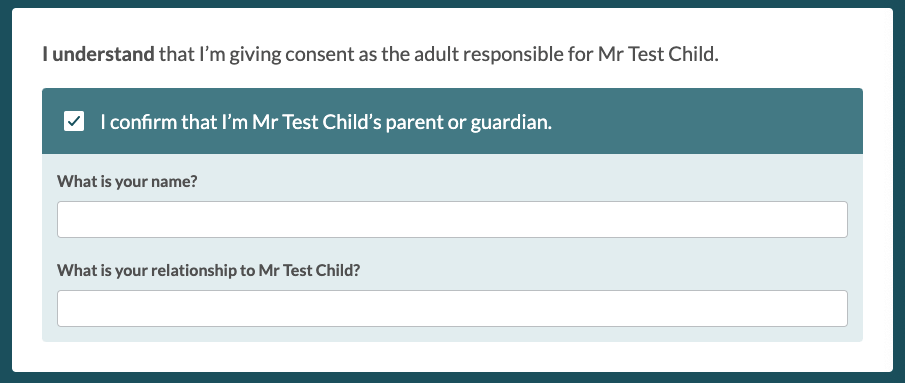Consent Form 2 - Agreement to treatment from an individual with parental responsibility
When should a Consent Form 2 be used?
A Consent Form 2 should be used where consent to treatment is being given by an individual with parental responsibility on behalf of a child.
The default position is that a Consent Form 2 should be used for children aged 0-15.
Young people aged 16 or 17 are, like adults, presumed to have capacity to decide on their own medical treatment, and therefore complete a Consent Form 1 themselves, unless there’s significant evidence to suggest otherwise.
Where a Consent Form 2 is being used in the context of a 16 or 17 year old, a capacity assessment should be completed documenting the evidence that the individual does not have capacity to make the decision about the proposed treatment.
Children under the age of 16 can consent to their own treatment if they’re believed to have enough intelligence, competence and understanding to fully appreciate what’s involved in their treatment. This is known as being Gillick competent. In this circumstance a Consent Form 1 should be completed, and a capacity assessment should be completed documenting the evidence that the individual is Gillick competent.
Who has parental responsibility?
Agreement to investigation or treatment for a child or young person that is not competent to give consent themselves can only be given by an individual with parental responsibility for the individual.
The person(s) with parental responsibility will usually, but not invariably, be the child’s birth parents. People with parental responsibility for a child include: the child’s mother; the child’s father if married to the mother at the child’s conception, birth or later; a legally appointed guardian; the local authority if the child is on a care order; or a person named in a residence order in respect of the child.
Fathers who have never been married to the child’s mother will only have parental responsibility if they have acquired it through a court order or parental responsibility agreement, or if they jointly registered the birth of the child with the mother (from 01 Dec 2003).
What are the differences between a Consent Form 1 and a Consent Form 2 in Concentric?
At a high level the structure of completing a Consent Form 1 and Consent Form 2 in Concentric are very similar, and therefore clinicians should have no difficulty using both as is appropriate for the context.
On creating a consent episode for a child or young person, Concentric presents the appropriate consent form type or options. For a child of 0-13 years a default of a Consent Form 2 is used. For patients who are 14-17 an option of completing a Consent Form 1 or a Consent Form 2 is presented. The appropriate type should be selected, as per the guidance above, and a capacity assessment documented if appropriate.
If a Consent Form 2 is selected there are a few minor differences compared to a Consent Form 1. On entering the consent flow (the ‘Are you ready to consent’ page) the individual with parental responsibility who is giving consent documents their details.

Options are presented regarding who will sign electronically. This can be either only the individual with parental responsibility, or that individual and the child. It is the individual with parental responsibility who is giving their consent, but a child’s signature is often also documented to demonstrate their assent to proceed with treatment.

One or both signatures are then documented in the same fashion as for a Consent Form 1.